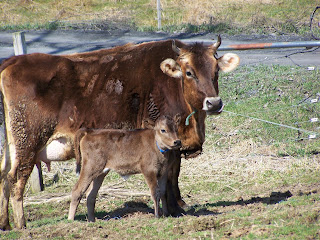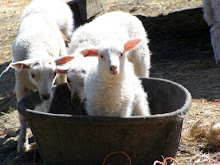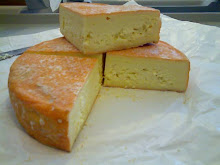Lambing, calving and cheese making, oh my! Well spring has truly sprung in Vermont as the grass has just begun on our farm to green up. Granny Smith green at this point. Birthing time always brings with it a season of obstetrics. Little sleep and then all of a sudden lots of babies on the ground. We have a ball watching the lambs, especially, frolicking with each other and engaging in their daily races. Lambs, like clockwork, run races of sorts until they are so out of breath, they all come to a screetching halt at once. How do they know when to all stop at the same time? It's as if it's a choreographed dance. Or perhaps they are a secret society.

Our calves, on the other hand, do what we call, boinging. All of a sudden they discover their legs and boing straight up in the air with tails held skyward and zoom across the field in a short burst. And then they are done.

The above photo is Peony, a first time mom, with her new baby, Carmela. Peony is half Jersey, half Brown Swiss. Unlike most dairies, we leave the babies on the moms for a bit to nurse. There are several reasons for this. For first time moms, it is very beneficial for the bonding process, and what is known as 'let-down'. This is the process of any lactating mammal of letting down her milk. She needs to get used to the sensation of having something nurse on her udder and it is stress-less. On the other hand, training a new mom in the milk parlor having never been nursed before can be a small nightmare. She must learn not only to walk into a very clean man-made room, hear a loud vacuum pump (which runs the milking machines), then stand still while a milker puts teat cups on her udder and then, lastly, let down her milk. So by leaving their babies on for a bit, they learn in a most natural way to let down and also give the farmers a small break during a most challenging and busy time of lambing and calving. Another huge benefit is of health. The calves get the antibody rich colostrum direct from their mothers.
The other day another baby born, to Iris, another Jersey-Brown Swiss.

Altho the heifer introducing herself to him is Bramble, who was born inconveniently in the middle of a blackberry bramble patch a few years ago. The markings on this baby are from his Dutch Belted father, with his semi-belt around his middle. Bramble herself is a Jersey-Dutch Belt cross and she didn't get the white belt either. Her mother, Reo, short for Oreo, has a most beautiful thick white belt across her middle.
 Then all that's left to do is form or package up the butter into whatever vessel you like. I like packing butter to be consumed soon in little ramekins.
Then all that's left to do is form or package up the butter into whatever vessel you like. I like packing butter to be consumed soon in little ramekins. 









